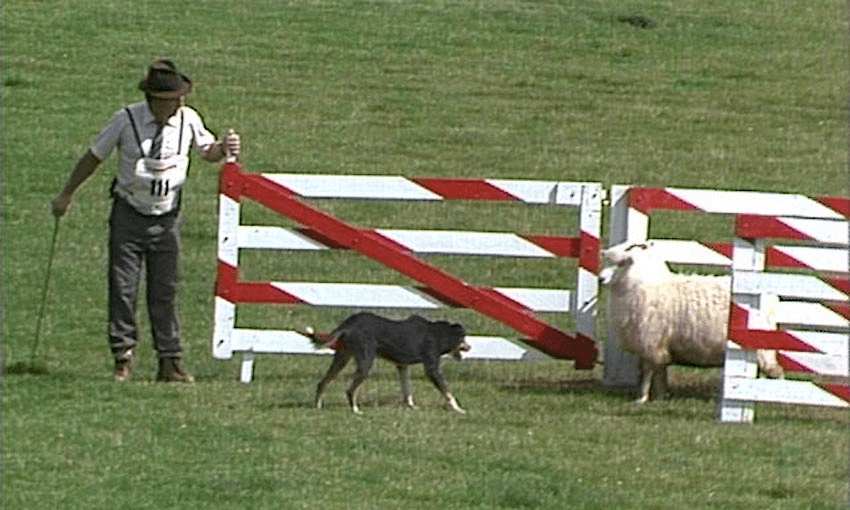I’m not joking, writes José Barbosa.
It has become part of our vague national perception of New Zealand culture to catalogue A Dog’s Show as a crusty anachronism. The show played during a time when stubbies (sartorial and intoxicant) completed the national costume, TV ads for Minties were montages of people hurting themselves, and everyone was totally sweet with Billy T James making fun of Asian people. A Dog’s Show has ended up being something American audiences find vaguely amusing on talk shows, offered as proof of New Zealand being so behind the times historians are actually flown in to observe how people used faxes and card based filing systems.
So it goes that the narrative we’ve all assumed is one where A Dog’s Show is yet another odd bit of our history from when life was so boring that we’re still unsure anything happened at all between the years of 1946 and 1981. It’s considered a classic TV show, but one that’s referred to as such with fond derision and jokey irony. I think to do so is a mistake.
In fact, I think A Dog’s Show deserves to be considered a seminal part of our culture. Not only that, but I believe A Dog’s Show is the best television programme New Zealand has ever made. And I’m not even joking.
Some would say the show’s premise is simple, even wafer thin. A farmer uses his dog to put some sheep in a pen. Yet within its apparently unyielding limits the show finds true drama. The best trials featured on the show culminate into an exquisite moment. This is where the last ewe is on the threshold of crossing the line into the pen. A great example can be watched in the final clip here. Once she moves over the line the farmer can legally slam the gate shut, completing his run. But she’s not moving, instead she stands there tall, proud and stupid.
In the foreground of the shot the dog stands hunched, drilling into the ewe with a stare that could finish Auckland’s Waterview connection tunnel three months early. Like two warring psychics in a cheap movie, dog and sheep are now in a gladiatorial battle of wills. The moment hangs there in its own apogee of instinct. Even the farmer who has been tweeting and warbling away like a tui with a lapel mic goes silent… and then momentum is restored. The ewe will either bolt or join its colleagues in the pen.
I challenge anyone watching, even ironically, to resist leaning in with anticipation at this moment. I once saw a show where a ewe brazenly walked out to the dog and stamped its hoof. It was the equivalent of watching the Welsh rugby team form a flying V and push their way through the haka. I nearly lost my shit.
It is perhaps the purest television example I can find of tension created by uncertainty in competition. Indeed, A Dog’s Show is unadulterated contest. It concerns itself with nothing but the game at hand. The farmers are never interviewed between runs (perhaps because when they are singled out for comment at finals, they tend to limit responses to “yep” and “nah”); we can only infer any sort of inner life from the Swandris and pressed trousers. Compare A Dog’s Show with its descendant Tux Wonder Dogs, which dresses up the competition to the point where it’s the TV equivalent of a Look Sharp store.
There are other elements that make A Dog’s Show a taonga of television craft. For a show whose colour palette seems to run in the deep browns and dull greens, it can be beautiful. In the episode I watched, a huntaway pauses at the crest of the hill and turns back to look at his master for instruction.
Maybe it’s just me, but here I see beauty in the lines of his form, his arched back, his taut front legs. It was only three seconds, but where else does television, particularly sports TV, spend that time to acknowledge elegance? They could have cut it out. But I can picture the director back at TVNZ looking at this shot and going “that dog looks fucking great!”
Presenter John Gordon deserves a lot of the kudos. He also deserves to be acknowledged as one of our best sports commentators. His voice brings stability and drapes the whole proceedings in a kind of homely prose: “Sticky and wobbly, rather like a jelly, that’s how Barry’s knees might be feeling right now because they don’t look like cooperative sheep.”
Gordon knows exactly when to bring the drama, particularly during the part of the doubles run when man and dog have to split or “shed” the six sheep into two pairs of three. His voice reduces to a whisper as dog circles sheep, “They look comfortable, don’t they?… So does Meg… glued to the spot.” As a farmer hoofs it after a runaway bunch of ewes, the urgency in Gordon’s voice ramps up the horror of lost points “RUN! RUN! RUN! … run down.”
This isn’t about how great TV was back in the old days – large portions of the TV landscape in any era are utter balls. Instead I’m arguing for A Dog’s Show to be repositioned as something to be proud of and that pride should be devoid of any irony. For 16 years every Sunday night we had a half hour show that elevated the everyday business of gruelling farm work into an art form. It concerned itself with the craft of making television and storytelling, it trusted the essence of competition rather than inanities and, best of all, it wasn’t boring. I think that’s something to celebrate.
